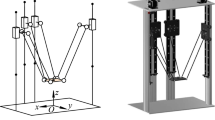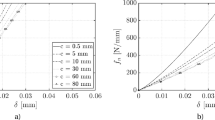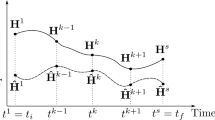Abstract
In this paper the effect of kinematic redundancy in order to reduce the singularity loci of the direct kinematics and to increase the operational, i.e., singularityfree, workspace is demonstrated. The proposed approach consists of additional prismatic actuators allowing one or more base joints to move linearly. As a result, a selective reconfiguration can be performed in order to avoid singular configurations. Exemplarily, kinematically redundant schemes of four structures, the 3RRR, the 3RPR, the 6UPS, and the 6RUS, are considered. The relationship between the redundancy and the operational workspace is studied and several analysis examples demonstrate the effectiveness of the proposed concept. Furthermore, the additional benefit of an increasing number of redundant actuators is discussed.
Similar content being viewed by others
References
Gosselin C M, Angeles J. Singularity analysis of closed-loop kinematic chains. In: Proceedings of IEEE Transactions on Robotics and Automation, 1990, 6(3):281–290
Sefrioui J, Gosselin C M. On the quadratic nature of the singularity curves of planar three-degree-of-freedom parallel manipulators. Mechanism and Machine Theory, 1995, 30(4):533–551
Gosselin C M, Wang J G. Singularity loci of planar parallel manipulators with revolute actuators. Robotics and Autonomous Systems, 1997, 21(4):377–398
Merlet J P. Redundant parallel manipulators. Laboratory Robotics and Automation, 1996, 8(1):17–24
Kock S, Schumacher W. A parallel x-y manipulator with actuation redundancy for high-speed and active-stiffness applications. In: Proceedings of the 1998 IEEE International Conference on Robotics and Automation, 1998, 3:2295–2300
Zhang L J, Li Y Q, Huang Z. Analysis of the workspace and singularity of planar 2-dof parallel manipulator with actuation redundancy. In: Proceedings of the 2006 IEEE International Conference on Mechatronics and Automation, 2006, 171–176
Wang J, Gosselin C M. Kinematic analysis and design of kinematically redundant parallel mechanisms. Journal of Mechanical Design, 2004, 126(1):109–118
Kock S. Parallelroboter mit antriebsredundanz. Dissertation for the Doctoral Degree. Institute of Control Engineering, TU Brunswick, Germany, 2001
Müller A. Internal preload control of redundantly actuated parallel manipulators-Its application to backlash avoiding control. In: Proceedings of IEEE Transactions on Robotics and Automation, 2005, 21(4):668–677
Ebrahimi I, Carretero J A, Boudreau R. 3-PRRR redundant planar parallel manipulator: Inverse displacement, workspace and singularity analyses. Mechanism and Machine Theory, 2007, 42(8):1007–1016
Cha S H, Lasky T A, Velinsky S A. Singularity avoidance for the 3-RRR mechanism using kinematic redundancy. In: Proceedings of the 2007 IEEE International Conference on Robotics and Automation, 2007, 1195–1200
Kotlarski J, Abdellatif H, Heimann B. On singularity avoidance and workspace enlargement of planar parallel manipulators using kinematic redundancy. In: Proceedings of the 13th IASTED International Conference on Robotics and Applications, 2007, 451–456
Kotlarski J, Abdellatif H, Heimann B. Improving the pose accuracy of a planar 3RRR parallel manipulator using kinematic redundancy and optimized switching patterns. In: Proceedings of the 2008 IEEE International Conference on Robotics and Automation, Pasadena, USA, 2008, 3863–3868
Kotlarski J, Do Thanh T, Abdellatif H, Heimann B. Singularity avoidance of a kinematically redundant parallel robot by a constrained optimization of the actuation forces. In: Proceedings of the 17th CISM-IFToMM Symposium on Robot Design, Dynamics, and Control, Tokyo, Japan, 2008, 435–442
Kotlarski J, Do Thanh T, Heimann B, Ortmaier T. Optimization strategies for additional actuators of kinematically redundant parallel kinematic machines. In: Proceedings of the 2010 IEEE International Conference on Robotics and Automation, Anchorage, USA, 2010, 656–661
Corbel D, Company O, Pierrot F. From a 3-DOF parallel redundant ARCHI robot to an auto-calibrated ARCHI robot. In: Proceedings the ASME 2007 International Design Engineering Technical Conferences and Computers and Information in Engineering Conference, Las Vegas, USA, 2007, 847–854
Arakelian V, Briot S, Glazunov V. Increase of singularity-free zones in the workspace of parallel manipulators using mechanisms of variable structure. Mechanism and Machine Theory, 2008, 43(9):1129–1140
Jin Y, Cheng I M, Yang G L. Kinematic design of a 6-DOF parallel manipulator with decoupled translation and rotation. In: Proceedings of IEEE Transactions on Robotics, 2006, 22(3):545–551
Jin Y, Chen I M, Yang G L. Kinematic design of a family of 6-DOF partially decoupled parallel manipulators. Mechanism and Machine Theory, 2009, 44(5):912–922
Merlet J P. Singular configurations of parallel manipulators and grassmann geometry. The International Journal of Robotics Research, 1989, 8(5):45–56
Bier C C. Geometrische und physikalische analyse von singularitäten bei parallelstrukturen. Dissertation for the Doctoral Degree. Institute of Machine Tools and Production Technology, TU Brunswick, Germany, 2006
Daniali H R M, Zsombor-Murray P J, Angeles J. Singularity analysis of a general class of planar parallel manipulators. In: Proceedings of the 1995 IEEE International Conference on Robotics and Automation, 1995, 2:1547–1552
Bonev I A, Gosselin C M. Singularity loci of planar parallel manipulators with revolute joints. 2nd Workshop on Computational Kinematics, 2002, 291–299
Li H, Gosselin C M, Richard M J. Determination of the maximal singularity-free zones in the six-dimensional workspace of the general Gough-Stewart platform. Mechanism and Machine Theory, 2007, 42(4):497–511
Hunt K H. Kinematic Geometry of Mechanisms. Clarendon Press, 1978
Yang G L, Chen W, Chen I M. A geometrical method for the singularity analysis of 3-RRR planar parallel robots with different actuation schemes. In: Proceedings of the 2002 IEEE International Conference on Intelligent Robots and Systems, 2002, 3:2055–2060
Gosselin CM, Angeles J. The optimum kinematic design of a planar three-degree-of-freedom parallel manipulator. Journal of Mechanisms, Transmissions, and Automation in Design, 1988, 110(1):35–41
Kotlarski J, Abdellatif H, Ortmaier T, Heimann B. Enlarging the useable workspace of planar parallel robots using mechanisms of variable geometry. In: Proceedings of the ASME/IFToMM International Conference on Reconfigurable Mechanisms and Robots, London, United Kingdom, 2009, 63–72
Zein M, Wenger P, Chablat D. Singular curves and cusp points in the joint space of 3-RPR parallel manipulators. In: Proceedings of the 2006 IEEE International Conference on Robotics and Automation, 2006, 777–782
Gough V E, Whitehall S G. Universal tyre test machine. In: Proceedings of the 9th FISITA-International Automobile Technical Congress, 1962, 117–137
Stewart D. A platform with six degrees of freedom. In: Proceedings of the Institution of Mechanical Engineers, 1965, 180(1):371–386
Grendel H. A platform with six degrees of freedom. Dissertation for the Doctoral Degree. Institute of Production Engineering and Machine Tools, Leibniz Universität Hannover, Hanover, Germany, 2004
Last P, Budde C, Hesselbach J. Self-calibration of the HEXAparallel structure. In: Proceedings of the 2005 IEEE Conference on Automation Science and Engineering, Edmonton, Canada, 2005, 393-398
Bonev I A, Gosselin C M. Geometric algorithms for the computation of the constant-orientation workspace and singularity surfaces of a special 6-RUS parallel manipulator. In: Proceedings of the ASME 2002 International Design Engineering Technical Conferences and Computers and Information in Engineering Conference, Montreal, Canada, 2002, 505–514
Author information
Authors and Affiliations
Corresponding author
Rights and permissions
About this article
Cite this article
Kotlarski, J., Heimann, B. & Ortmaier, T. Influence of kinematic redundancy on the singularity-free workspace of parallel kinematic machines. Front. Mech. Eng. 7, 120–134 (2012). https://doi.org/10.1007/s11465-012-0321-8
Received:
Accepted:
Published:
Issue Date:
DOI: https://doi.org/10.1007/s11465-012-0321-8




